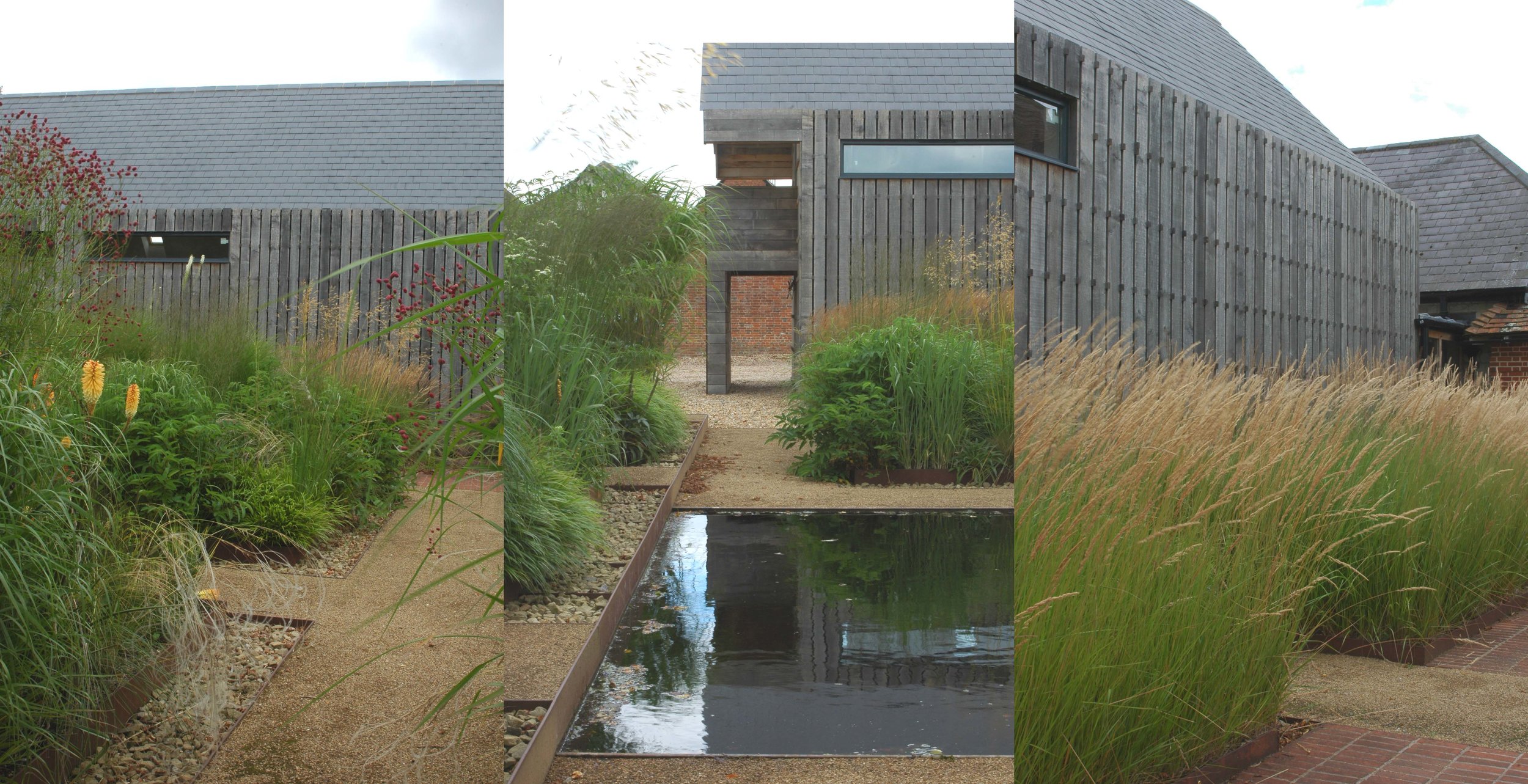Dichotomy of a Modern Garden: Bury Court
It is rare to find a garden that is a product of two designers - especially one runs the risk of creating a bipolar identity. Bury Court represents the fulcrum of two designers whose styles seem superficially similar, but upon closer inspection are different.
It is considered the first British commission that the Dutch designer Piet Oudolf designed in 1997 after John Coke, the owner of Bury Court, sought someone to collaborate on the courtyard garden. With Marina Christopher, John Coke operated the now-closed specialist nursery Green Farm Plants, one of the first nurseries to sell herbaceous perennials and grasses popular in today's contemporary gardens. Coke found a kindred soul in Oudolf who combined plantsmanship and design (it didn't hurt that Oudolf and his wife Anja ran a successful nursery selling similar plants as Green Farm).
Oudolf countered the asymmetrical shape of the exposed courtyard with curving beds book-ended with mounds and swirls of topiary. He filled the beds with his typical controlled compositions of perennials and grasses that are the defining norm for this style. The low to medium heights of Molinia caerulea and Deschampsia caespitosa are exploited for stylized meadows mixed with Dianthus carthusianorum and Allium sphaerocephalon and Digitalis ferruginea. Copied much elsewhere, these meadows have been reinvented in Oudolf's subsequent gardens. Only the gravel garden and the formal pool feels slightly awkward, but exist as vestiges of the site's former nursery. If the garden seems humbling in the light of his later work, it is due to its domestic scale limiting the drifting style Oudolf normally applies to expansive spaces.
Like Oudolf, Christopher Bradley Hole favors the large-scale use of grasses and herbaceous perennials. In an interview with garden writer and designer Mary Keen, Bradley Hole admits a particular fondness for plants 'invaluable in their ability to reproduce, in an abstract way, the unique forms and seasonal changes within a garden setting.' It is where this similarity with Oudolf begins and ends. Whereas Oudolf strives for a rather effortless, but romantic feeling reminiscent of natural landscapes, Bradley Hole aims for a minimalist and abstract interpretation. His herbaceous plantings often are squared off by paths, paved or grassed, and blocks of boxwood, yew, and field maple reinforces their geometric patterns. He unabashedly mixes different grasses together than adhere to the conventional practice of block planting - Miscanthus, Molina, Hakonechloa, and Stipa gigantea. His love of grasses does not diminish his soft spot for British native trees, especially Acer campestre (field maple) for its flexibility as a specimen tree or hedge. The results come together in his signature look - a grid-like labyrinth of twenty beds flowing with herbacous perennials and grasses and cordoned off by hedges seen here at the Bury Court garden created in 2003. In its hearth lies a tall oak pavilion adjoining a black pool, and north of the garden is a weathered oak garage building anchored by a grand sweep of Calamagrotis x acutiflora 'Karl Foerster'.
Intimate and abstract are not symbiotic, but they curiously come together here. As you enter the pathways, you disappear from sight as the grasses and tall perennials engulf you, creating that experience of being in a meadow or forest. One can imagine how transcendent it can be when the grasses become a shimmering sea of silvery plumes in autumn. It is the same effect seen at another superb garden Le Jardin Plume, France.
Of the two gardens, the Oudolf garden, once novel and innovative, looks funnily dated (I remember being asked by a friend which of the two I liked better) as its look has become much emulated elsewhere in the UK and continental Europe. The diversity of herbaceous perennials and grasses has given it a semblance of the traditional herbaceous border. Oudolf's current style has since evolved from that of Bury Court - the topiary here that too defined Hummelo no longer plays a seminal role as it did in his early work (the wing-like yew hedges emblematic of Hummelo no longer exists). Blocky plantings have become looser or to borrow the oft used planting vocabulary 'intermingling'. Innovative or not, there is no denying the significance of Oudolf’s Bury Court garden as a pivotal example of his early work. On the other hand, the Bradley Hole garden feels more fresh, helped by its simplicity in the linear dimensions and more restricted plant spectrum. It is an outstanding example of how the 'naturalistic' look can be tailored to a modernist garden without compromising its ethos.
Related Links
Planting: A New Perspective (www.plinthetal.com)
Pettifers (www.plinthetal.com)
~Eric









